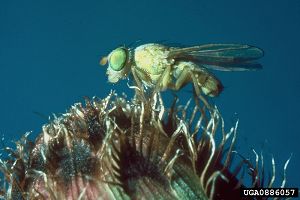Terellia virens
(Diptera: Tephritidae)
green knapweed clearwing fly
Biological Control Agent Links: Bio-Control-main
Photo: Photographer: CABI Biosciences Archives Image Usage - (please read before using this image)
Larvae Adult
Origin: Native of Europe. (2)
Life cycle:
Over wintering stage: The second-generation prepupae hibernate in cocoons embedded in knapweed seed heads. (1)
Egg stage: The production of the eggs takes place from the end of June until early fall. The females produce around 80 eggs. These are deposited in the flower heads between the flowers. She then leaves a scent that discourages other females from laying eggs in the same flower. The larvae hatch about 3-5 days after the eggs have been laid (depending on terprature). The eggs are elongated and about 1.0 mm, long and white. (1)
Larval stage: This stage takes around 14 days to mature into the pupation stage in the first generation or prepupation stage in the second generation of the year. Feeding is on developing seeds, the first and second generation instars later consume other seeds, or receptacle tissues. The larvae are white but then turn yellow-brown as they get older. (1)
Pupil stage: First generation larvae pupate in a loose cocoon of plant hairs. The second generation prepupae hibernate in a partially positioned cocoon that is in the receptacle of the flower. They are yellow-brown in color. They emerge as adults the following spring or summer. (1)
Adult stage: The adult stage happens from mid-May until the end of August. They are alive from 22 to 48 days. The females have ovaries that are full of immature eggs. The eggs mature in a week. The adult flies feed on knapweed nectar. The adults are pretty small, 4 to 5 mm long, they are a green-gray and their wings are clear. (1)Effect:
Destructive stages: Larval, damages seed heads and destroys many seeds. (1)
Plant species attacked: Spotted knapweed (C. maculosa) is its host but, diffuse knapweed (C. diffusa) is also eaten. (2)
Damage to host: The fly reduces the seed production. (2)
Releases:
First introduced into the United States: Montana in 1992. (1)
Now established in: Oregon and Montana. (1)
Habitat: The best habitat is spotted knapweed infestations. (1)
Availability: Limited amounts for the state of Oregon. (1)
Stage to transfer: Prepupal and adult. (2)
Redistribution: The best way to distribute these is to collect infected knapweed seed heads in the fall. Then put them in sleeve boxes and place them in a refrigerator at 4-8 degrees C. Tie them to a post or tree (up off the ground) within your knapweed patch in very early spring and the flies should emerge at the correct time later in the spring or summer. (1)
Comments: This fly doesn't survive very well in the seed heads where Larinus minutus are also living. (1) We still can not find much information on this insect. [Breitenfeldt, Todd].
5 Links:
1) http://www.nysaes.cornell.edu/ent/biocontrol/weedfeeders/ter...
2) http://zipcodezoo.com/Animals/T/Terellia_virens/
3) http://www.oregon.gov/ODA/PLANT/WEEDS/bio_profile_tevi.shtml
4) http://www.forestryimages.org/browse/subimages.cfm?sub=3130
5) http://www.ipmimages.org/browse/subimages.cfm?sub=3130
We are having trouble finding more useful links... If you know of any, please email me. [Breitenfeldt, Todd].
Bibliography:
1) Biological Control of Weeds in the West, published by: Western Society of Weed Science, edited by: Rees, Norman E., Quimby, Paul C. Jr., et. al., Bozeman, Montana.
2) Lang, R.F., USDA-APHIS-PPQ, http://www.nysaes.cornell.edu/ent/boicontrol/weedfeeders/terellia_virens.html, Bozeman Biocontrol Facility, Forestry Sciences Laboratory, Montana State University, Bozeman, Montana.
By: Lynsey S. and Robby B., 02/03. Updated By: Megan Enriquez 3-2-09
Edited by: Ian MacMurdie 2/9/05.
mtwow.org HOME Back to Biological Control Agents, by Weed
